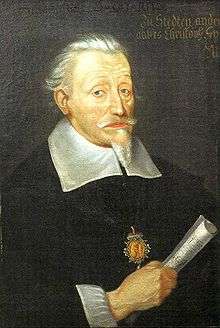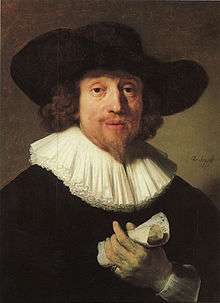Heinrich Schütz

Heinrich Schütz (German: [ʃʏʦ]; 18 October [O.S. 8 October] 1585[1] – 6 November 1672[2]) was a German composer and organist, generally regarded as the most important German composer before Johann Sebastian Bach and often considered to be one of the most important composers of the 17th century. He wrote what is traditionally considered to be the first German opera, Dafne, performed at Torgau in 1627, the music of which has since been lost. He is commemorated as a musician in the Calendar of Saints of the Lutheran Church on 28 July with Johann Sebastian Bach and George Frideric Handel.
Early life
Schütz was born in Köstritz, the eldest son of Christoph Schütz and Euphrosyne Bieger.
In 1590 the family moved to Weißenfels, where his father managed the inn "Zum güldenen Ring". His father eventually served as burgomaster in Weißenfels, and in 1615 purchased another inn known as both "Zur güldenen Sackpfeife" and "Zum güldenen Esel" – which he renamed "Zum Schützen".
While Schütz was living with his parents, his musical talents were discovered by Moritz von Hessen-Kassel in 1598 during an overnight stay in Christoph Schütz's inn. Upon hearing young Heinrich sing, the landgrave requested that his parents allow the boy to be sent to his noble court for further education and instruction. His parents initially resisted the offer, but after much correspondence they eventually took Heinrich to the landgrave’s seat at Kassel in August 1599.
After being a choir-boy he went on to study law at Marburg before going to Venice from 1609–1612 to study music with Giovanni Gabrieli. Gabrieli is the only person Schütz ever referred to as being his teacher. He also inherited a ring from Gabrieli shortly before the latter's death. He subsequently was organist at Kassel from 1613 to 1615.
Dresden (1615-1672)
Schütz moved to Dresden in 1615 to work as court composer to the Elector of Saxony. He mostly from that point forward, composed in Dresden, which were lightly orchestrated, compared to his compositions before the Thirty Years War. In 1619 Schütz married Magdalena Wildeck who had been born in 1601. She bore two daughters before her death in 1625: Anna Justina born in 1621 and Euphrosyne born in 1623.
In Dresden Schütz sowed the seeds of what is now the Sächsische Staatskapelle Dresden, but left there on several occasions; in 1628 he went to Venice again, where he met and studied with Claudio Monteverdi. In 1633 he was invited to Copenhagen to compose the music for wedding festivities there, eventually returning to Dresden in 1635. He again conducted an extended visit to Denmark in 1641. The Thirty Years War ended in 1648, and he became more active. In 1655, the year that his daughter Euphrosyne died, he accepted an ex officio post as Kapellmeister at Wolfenbüttel.
Schutz did not put on large-scale compositions until the 1660s, when he composed the greatest Passionmusic before Bach.[3]
Schütz died in Dresden from a stroke in 1672 at the age of 87.[4] He was buried in the old Dresden Frauenkirche, but his tomb was destroyed in 1727 when the church was torn down to build the new Dresden Frauenkirche.
His pupils included Anton Colander, Christoph Bernhard, Matthias Weckmann, Heinrich Albert, Johann Theile, Friedrich Werner, Philipp Stolle Johann Nauwach, Caspar Kittel, Christoph Kittel, Clemens Thieme, Johann Klemm, Johann Vierdanck, David Pohle, Constantin Christian Dedekind, Johann Jakob Loewe (or Löwe), Johann Kaspar Horn, Friedrich von Westhoff, Adam Krieger, Johann Wilhelm Furchheim, Carlo Farina.[5][6] See: List of music students by teacher: R to S#Heinrich Schutz.
Style
Schütz's compositions show the influence of his teacher Gabrieli (displayed most notably with Schütz's use of resplendent polychoral and concertato styles) and of Monteverdi. Additionally, the influence of the Netherlandish composers of the 16th century is prominent in his work. His best known works are in the field of sacred music, ranging from solo voice with instrumental accompaniment to a cappella choral music. Representative works include his Psalmen Davids (Psalms of David, Opus 2), Cantiones sacrae (Opus 4), three books of Symphoniae sacrae, Die sieben Worte Jesu Christi am Kreuz (Seven words of Jesus Christ on the Cross), three Passion settings and the Christmas Story. Schütz's music, while starting off in the most progressive styles early in his career, eventually grew into a style that is simple and almost austere, culminating with his late Passion settings. Practical considerations were certainly responsible for part of this change: the Thirty Years' War had devastated the musical infrastructure of Germany, and it was no longer practical or even possible to put on the gigantic works in the Venetian style which marked his earlier period.
The unique composition "Es steh Gott auf" (SWV 356) is in many respects comparable to Monteverdi.[7]
Schütz was one of the last composers to write in a modal style. His harmonies often result from the contrapuntal alignment of voices rather than from any sense of "harmonic motion"; contrastingly, much of his music shows a strong tonal pull when approaching cadences. His music includes a great deal of imitation, but structured in such a way that the successive voices do not necessarily enter after the same number of beats or at predictable intervallic distances. This contrasts sharply with the manner of his contemporary Samuel Scheidt, whose counterpoint usually flows in regularly spaced entries. Schütz's writing often includes intense dissonances caused by the contrapuntal motion of voices moving in correct individual linear motion, but resulting in startling harmonic tension. Above all, his music displays extreme sensitivity to the accents and meaning of the text, which is often conveyed using special technical figures drawn from musica poetica, themselves drawn from or created in analogy to the verbal figures of classical rhetoric. However, as noted above, the composer's style became simpler in his later works, which make less frequent use of the kind of distantly related chords and licences found in such pieces as "Was hast du verwirket" (SWV 307) from Kleine geistliche Konzerte II.
Beyond the early book of madrigals, almost no secular music by Schütz has survived, save for a few domestic songs (arien) and occasional commemorative items (such as Wie wenn der Adler sich aus seiner Klippe schwingt (SWV 434), and no purely instrumental music at all (unless one counts the short instrumental movement entitled "sinfonia" that encloses the dialogue of Die sieben Worte), even though he had a reputation as one of the finest organists in Germany.
Schütz was of great importance in bringing new musical ideas to Germany from Italy, and as such had a large influence on the German music which was to follow. The style of the North German organ school derives largely from Schütz (as well as from the Dutchman Jan Pieterszoon Sweelinck); a century later this music was to culminate in the work of J.S. Bach. After Bach, the most important composers to be influenced by Schütz were Anton Webern and Brahms, who is known to have studied his works.
Works

The following are major published works; most of these contain multiple pieces of music; single published works are also listed in the complete work list, including major works such as the Seven Last Words, and the Passions (according to Matthew, Luke, and John). There are over 500 total surviving individual pieces by Schütz.
- Il primo libro de madrigali (first book of madrigals) (opus 1, Venice, 1611)
- Psalmen Davids (Book 1) (opus 2, Dresden, 1619)
- Historia der ... Aufferstehung ... (The Resurrection) (opus 3, Dresden, 1623)
- Cantiones sacrae (opus 4, Freiberg, 1625)
- Becker Psalter (opus 5, Freiberg, 1628, revised 1661)
- Symphoniae sacrae (Book 1) (opus 6, Venice, 1629)
- Musikalische Exequien (opus 7, Dresden, 1636)
- Kleine geistliche Konzerte (Book 1) (opus 8, Leipzig, 1636)
- Kleine geistliche Konzerte (Book 2) (opus 9, Leipzig, 1639)
- Symphoniae sacrae (Book 2) (opus 10, Dresden, 1647)
- Geistliche Chor-Music (opus 11, Dresden, 1648)
- Symphoniae sacrae (Book 3) (opus 12, Dresden, 1650)
- Zwölf geistliche Gesänge (opus 13, Dresden, 1657)
- Historia der ... Geburt ... Jesu Christi (Christmas Story; Dresden, 1664)
- Lukas-Passion (The Passion According to St. Luke) (Dresden, 1665)
- Johannes-Passion (The Passion According to St. John) (Dresden, 1666)
- Matthäus-Passion (The Passion According to St. Matthew) (Dresden, 1666)
- Königs und Propheten 119er Psalm ... (Psalm 119, Psalm 100, and German Magnificat: "Swan Song") (opus ultimum, Dresden, 1671)
References
- ↑ Gregory S. Johnston (ed.), A Heinrich Schütz Reader: Letters and Documents in Translation, Oxford University Press, 2013, p. 85.
- ↑ Joshua Rifkin, et al. "Schütz, Heinrich." Grove Music Online. Oxford Music Online. Oxford University Press, accessed October 8, 2013. Online: .
- ↑ Cummings, Robert. "Heinrich Schütz". allmusic.com. Retrieved 8 February 2016.
- ↑ Heinrich Schütz 1585-1672
- ↑ David Mason Greene Greene's biographical encyclopedia of composers p. 115 "When the elector finally let him go, Schütz managed to wrest from him money to permit his pupil and protégé Matthias Weckmann to study in Hamburg for three years with Jakob Praetorius. He remained in the Danish court for two years, "
- ↑ The encyclopedia of the Lutheran Church Julius Bodensieck, Lutheran World Federation - 1965 "The most eminent among his pupils were H. Albert, M. Weckmann, D. Pohle, Chr. Bernhard, JJ Loewe, A. Krieger, J. Theile."
- ↑ Gerald Drebes: ‘‘Schütz, Monteverdi und die „Vollkommenheit der Musik“ – „Es steh Gott auf“ aus den „Symphoniae sacrae“ II (1647)‘‘. In: ‘‘Schütz-Jahrbuch‘‘, Jg. 14, 1992, pp. 25–55. Online: .
- ↑ cf. Steude 1986, pp. 58–61
Sources
- Manfred Bukofzer, Music in the Baroque Era. New York, W.W. Norton & Co., 1947. ISBN 0-393-09745-5
- Wolfram Steude, Zum gegenwärtigen Stand der Schütz-Ikonographie., in: Schütz-Jahrbuch 1985/86. Kassel, Bärenreiter, 1986, p. 50-61. ISBN 3-7618-0778-3
- Basil Smallman: Heinrich Schütz, The Master Musicians, 2000.
- Tamsin (née T.D.) Jones, "Passions in Perspective: An Analytical Discussion of the Three Passions of Heinrich Schütz (1585–1672) against their Historical and Stylistic Backgrounds" (Ph.D. thesis, University of Birmingham, 2000)
- Heinrich Schütz: "Geistliche Chor-Music, Op. 11." Edited by Andrew Thomas Kuster. Ann Arbor, MI, 2005. ISBN 1-4116-4243-0.
Further reading
- Hoffer, Brandi (2012). "Sacred German Music in the Thirty Years' War", Musical Offerings: Vol. 3: No. 1, Article 1.
External links
-
 Media related to Heinrich Schütz at Wikimedia Commons
Media related to Heinrich Schütz at Wikimedia Commons - Free scores by Heinrich Schütz at the International Music Score Library Project
- Germany Fed. Rep. 1972 stamp devoted to Heinrich Schütz
- Free scores by Heinrich Schütz in the Choral Public Domain Library (ChoralWiki)
-
 "Schütz, Heinrich". New International Encyclopedia. 1905.
"Schütz, Heinrich". New International Encyclopedia. 1905.
